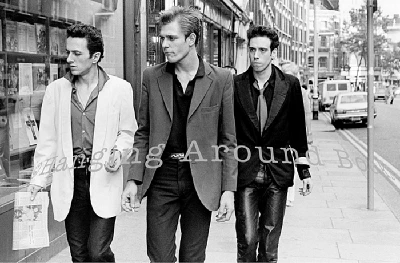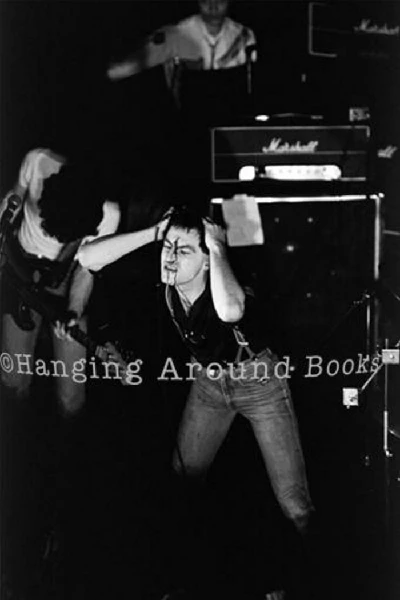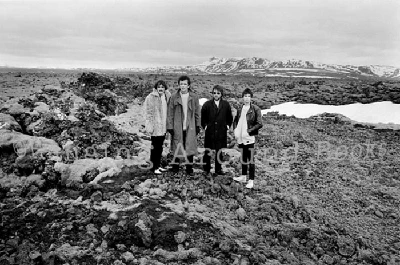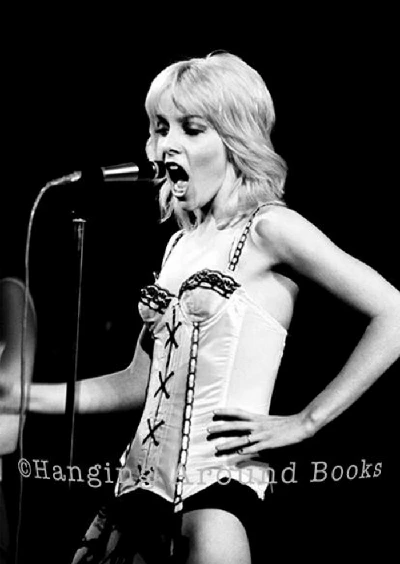published: 23 /
2 /
2020
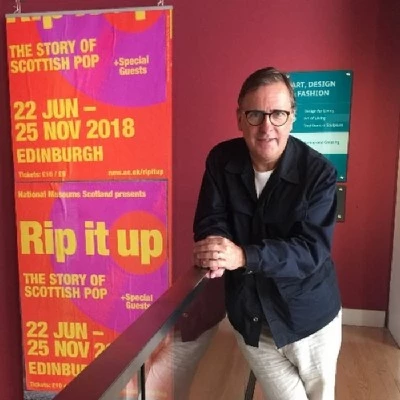
John Clarkson talks to music business consultant and ex-journalist Ronnie Gurr about his independent book publisher Hanging Around Books, which specialises in music-related photobooks.
Article
“Doing this is the best thing that I have ever done,” says Ronnie Gurr. “There are a lot of opportunities for me to play golf where I live, but I would rather poke my eyes out than do that. I love doing this as a hobby, but it has grown into more that and turned into a little business, a little cottage industry."
Gurr is sitting in a cafe/bar in Edinburgh’s West End, talking to Pennyblackmusic about Hanging Around Books, his independent book publishing firm which specialises in music-related photobooks. He was raised less than a mile away in the Fountainbridge area of the city, but has travelled in for the interview from Dunbar, a picturesque seaside town thirty miles down the Lothian coastline where he has lived for the last few years.
Ronnie Gurr has worked in the music business for over forty years. He started out in the mid-1970s by writing and publishing his own punk fanzine ‘Hanging Around’, which ran to seven editions, and led to him becoming a freelance music writer at ‘NME’ and the still much missed ‘Record Mirror’. From there he went on to work at Arista Records, handling press for artists such as the Boomtown Rats and Simple Minds, before at the age of just 22 in 1982 becoming an executive at Richard Branson’s Virgin Records. He also worked in the 1990s for Sony’s Columbia Records, and latterly as a creative director for Branson again at his V2 label. He is credited over the years for masterminding the rise of artists as diverse as Culture Club, Alison Moyet, Kula Shaker and the Stereophonics.
Now “semi-retired”, he has helped organise a rock school in the Highlands, and, infamously dubbed at the time by ‘The Sun’ as being “the Indiana Jones of Scottish rock and pop”, was a consultant for ‘Rip It Up’, an exhibition on Scottish pop which ran for four months in 2018 in the Royal Museum of Scotland in Edinburgh, persuading some of the music industry’s biggest names to part with their memorabilia for it. He continues to be involved in other consultancy work.
Gurr has since 2017 published over thirty photobooks with Hanging Around Books, which is named in tribute to and run along the same do-it-yourself principle as his former fanzine. The books, which tend to run between 32 and 36 pages each and are printed on A5 paper, come in cheap at £9.95 plus postage and packaging, and have so far focused largely but not exclusively on punk and post-acts from the mid-1970s to the mid-1980s. They feature rare and previously unseen images, and some of the artists that have been the subject of Hanging Around’s photobooks have included the Blue Nile, the Skids, the Human league, Culture Club, Stiff Little Fingers, Japan and Depeche Mode.
Ronnie Gurr has unearthed some stunning and often startling images. In his own book, which was the first in the series, ‘So Far, So Distant and So Long Ago: Simple Minds in Berlin 1980’, the young Jim Kerr stands in solitude on a large wasteground against the stark backdrop of the Berlin Wall. Virginia Turbett in her book ‘Draw Another Breath: The Clash 1979/1980’ follows the charismatic punks with her camera as they walk defiantly through the streets of South London. In another Turbett photozine ‘South of London: The Ruts 1978-1979’, the late Malcolm Owen, shellshocked and bleeding badly from the forehead after being hit by a can, battles on to finish a gig. Jill Furmanovsky’s ‘There Goes the Charabang; The Stranglers in Iceland’ finds the group at the time of their 'Black and White' album on an unlikely press trip amidst icebergs and glaciers, and Andre Csillag’s ‘School’s Out 1976-77: The Runaways in the UK’ tails the teen girls group to an inappropriate after party involving a male stripper at a seedy club.
It is very evident in talking to him that Ronnie Gurr is absolutely passionate about Hanging Around Books. He is very articulate, has some excellent stories and anecdotes, and is often very funny. It is an interview in which Pennyblackmusic doesn’t have to work too hard, and, other than making the occasional pointer, just needs to sit back and listen.
1. The Background
Towards the end of 2016, there was a punk exhibition in the British Library in London, marking its 40th anniversary. They bizarrely had a copy there of my fanzine ‘Hanging Around’, which I had written in ‘76/’77. A friend of mine called me and said, “I am in the British Library and looking at your magazine”, and I said, “Don’t be ridiculous!” and then two words of which the second one was “Off!” He took a photo and sent me it on his phone, and it was only then that I started to believe him. I have got no idea how they got a copy as we only did a couple of hundred copies, which were just sold in Edinburgh and Glasgow. There is a mandatory legislation that anyone who publishes anything has to lodge it which is I what do with these books, but at the time I was eighteen. I didn’t know anything about that. I have got no idea how they got a hold of it to this day.
I also read a book at about the same time called ‘Self Publish, Be Happy!’ which resonated with the fanzine and how I used to do that. Punk gave opportunities to a lot of people, myself included. I was going to go to Napier College in Edinburgh to study to be a journalist, and suddenly in ‘76 I could be a journalist without having to do that, and I could be a publisher thanks to High Street photocopying shops. So, I did my fanzine on that basis, and it opened up a world of possibilities, and out of that I became a freelance journalist for ‘NME’ and ‘Record Mirror’, and that was me getting started at the age of eighteen. I have been involved in music ever since. It blew open the doors for me doing that fanzine.
So, there was the punk exhibition at the British Library, and there was the fact that I had read that book ‘Self Publish, Be Happy’, and there was also the fact that my wife wanted me to clear out our garage and “my archive”. She disparagingly calls it “our garage”, but to me it is “my archive”. As I was clearing it out, I found these photos I had taken of Simple Minds in Berlin on a European tour in support of Peter Gabriel in September 1980. For my 21st birthday, my mum and dad bought me a Nikon EM camera. The Nikon EM was the real budget version of the mass market Nikon, and I took that with me on my last job for ‘Record Mirror’, which was to interview them on that tour. For some reason 'Record Mirror' didn’t send a photographer. Usually I went on assignments with photographers, many of whom are my contacts now, so I took my camera, took some photos of Simple Minds and forgot about them.
I have always collected photo books. I am a big fan of photography, especially music photography, so all those things just aligned and those Simple Minds photos became Hanging Around’s first book.
It didn’t work out great for my wife though, as we have now got boxes of these things clogging out our garage, and what started out as an exercise to clear it has made it a lot more full.
2. The Books
Some of the photos have been seen before, but most of them are quite rare. I like to put them together in little photo essays. There are no words in them, apart from a one page introduction from the photographer. The idea is that the photos will tell the little story that is going on there.
A lot of people will be aware, for example, of Ray Stevenson’s Sex Pistols photos, which have been seen everywhere. I said to him, “Is there anything else that you have got?”
I had just done a Sex Pistols book with Virginia Turbett. It was her first job for ‘Sounds’, and they were doing a video for ‘Pretty Vacant’, and she spent an afternoon with them while they were doing the video, so you have got Sid Vicious eating a kebab on the break, and them sitting outside the pub while they were waiting for a set-up for the video.
I didn’t want to do another Sex Pistols book, and Ray told me that he had spent three weeks on tour with Siouxsie & The Banshees in the States in 1981, and he showed me these great shots of them crossing over the border into Mexico and lots of other unseen stuff. It was great to do that, and that is the kind of stuff that works for me best - the Banshees in the southern states of America as opposed to the Banshees playing at the 100 Club, of which there are quite a lot of images out there already.
I tend to look for something a bit different. Most of the photographers were working for music papers at the time, who just wanted a shot of the band and four individuals up against a wall, or if it was a live shot the singer in front of a mic with a guitar.
I was doing a Clash book with Virginia Turbett of photos that she had taken of them in 1979 and 1980. As I was going through the archives with her, there was a great photo and I said to Virginia, “I really love that photograph,” and she said, “No, I don’t want that one in the book,” and I said, “Why not?” She said, “Those two women ruined my photo,” and I said, “No, those two women made your photo.” That picture would never have been used in ‘Sounds’ or ‘NME’ or ‘Melody Maker’ because it is a photo of the Clash outside a greengrocer’s shop somewhere in South London, Brixton maybe. The owner of the shop is rearranging her vegetables in boxes outside the shop and ignoring them, and leaving the image stage right is a woman who is looking out the corner of her eye scowling at them. That makes the photo for me, but Virginia had never printed that because it would have never earned her anything in the music press. A lot of the joy of doing this for me is going through the contacts and finding great images like that.
3.Printing and Distributing
I work with a designer who knocks them into shape, an old friend in Newcastle called David Lloyd, and then I get them printed locally in Dunbar at Lothian Printers, who I can’t recommend highly enough. Malcolm there does a great job for me. Someone said to me just after I started doing the books, “Oh, you could get them printed cheaper in China,” and I said, “Well, actually, if I have got a problem I take a ten minute walk and have a cup of tea with my printer, and I would much rather put the business through a local business”.
4. The Photographers
The good thing is that we have now got a backlog. We have got photographers who are now sending us stuff. It was probably more time-consuming earlier as I had to go out and find people, but I kind of know what is in people’s archives now.
It has been nice being able to work with people like Ray and Jill Furmanovsky, who did a book on the Stranglers in Iceland with us last year. I had done a couple of polls with customers asking who they would like to see a book about, and both times the Stranglers came out top, heads and shoulders above everyone else. I always remembered that when their ‘Black and White’ album came out in 1978 the Stranglers had a press junket out in Iceland, and that Jill and Pennie Smith were both there. The Stranglers were in this volcanic landscape with lots of glaciers, which is a bit more interesting than them being up some alleyway in Soho.
So, I got in touch with Jill about doing a book of their Icelandic photos. Jill runs the Rock Archive website (www.rockarchive.com) and sells prints for a lot of money. She has the work of about a hundred photographers in the archives there, and if you look at someone like Pennie Smith, that famous Paul Simonon/Clash photo, you will pay £2,000 or £3,000 for that print there. I was nervous about speaking to Jill because her prints are top drawer. They are not cheap. They are not an impulse buy, and there was me with my tenner photozines. I thought she might turn me down, but she loved them. Her attitude is very much that Hanging Around Books is a way for people to get into music photography for a reasonable price.
5. Pricing
I always say to the photographers that I want to keep the price low. It is £9.95 plus postage. Printing costs have gone up during the last few years, but I don’t want to put the price up. I think that it is important that they are under a tenner and people aren’t precious about them. They can flick through them or throw them on the coffee table. They are not £200 Taschen things which need to be kept in pristine condition. They are meant to be looked at. They are meant to be enjoyed, so it is important that they are kept accessible. If you want to go and find an original print printed on top quality paper and silver gelatine print, they are out there. If you do, that is fine, but if you don’t the books are there. The other good thing, of course, is that most of this stuff was gathering dust in the archives, but I have given them a life.
6. The Photo Essay
I always welcome seeing photos, but if somebody sends me, say, two contact sheets where one of the contact sheets is twenty images of the singer with a microphone, and then there are twenty other images, five of the drummer, five of the bassist, five of the keyboard player and five of the audience, then it is not really enough to do a book.
You want a bit of variety. One of the things I always say to photographers is “Have you got any photos of roadies?” I would love to do a book on roadies, but you never get photos of roadies. There is one photographer that I might do something with, who spent a day when the Hydro opened in Glasgow and did a lot of time lapse stuff. They brought three articulated lorries inside the building for the opening concert with Rod Stewart, and he took lots of photos of those and the racks of guitars and the power rack supply. They are really nice images and they are music-related, so they would kind of fit.
I am looking for anything that is a little photo essay really. You can get some great live images, but I am usually looking for a bit more than that. We have just done a book on the Runaways with Andre Csillag, which is a good example, of two different shows they did two different line-ups in London in '76 and '77. Andre has got live stuff and he has got stuff backstage, but after the second gig they were taken to the after-party at a seedy club where there was a male stripper - and I have to say not an especially attractive male stripper - flaunting his wares. The Runaways were, I suppose, sexually provocative. They were a ballsy all-girl band, and that is something that you would not necessarily see in the history of the Runaways. It was just something a bit different that told a different part of the story.
7. Censorship
When I put up a link on my Facebook page, it automatically links to the images which are on the Hanging Around Books website. There is a photo in the Runaways book of Cherie Currie wearing a basque, stockings and suspenders, which was her on-stage uniform, and Facebook bopped it because they said it was adult-oriented material. I appealed it, and, to be fair to them, it was up again in 48 hours.
They also took down the Ruts. There is the photo in a book we did on the Ruts with Virginia Turbett of Malcolm Owen, who has been hit by a can and he has got blood running down his face, and they took that down because they said it was a violent image.
The best one, however, was of Mick Jagger. We did a book, with photos by Justin Thomas, of a secret gig they did at the 100 Club in 1982. The cover of the Stones book has a photo of Mick Jagger. The 100 Club holds a couple of hundred people,so it was very sweaty and he took his top off, and because Mick Jagger’s nipple is on the front cover it was barred from Facebook. I had to re-edit it. The photo that you see on the website is re-edited to take it up his chest a bit so his nipple isn’t showing. It is nonsense. You can post some of the most evil right-wing and racist shit and that gets through, but Mick Jagger’s nipple won’t get through.
8. The Future
There are no hard and fast rules really about what I might publish. I was offered a prog rock band which I might do because I like the photos. It is as much about the imagery as it about the bands. The reason so much of it is in the punk/post-punk period is because I know a lot of the photographers and the bands from that period.
I am not ruling anything out though. If there was a new band and the photography was great and warranted it, I would do it.
Ray Stevenson has got an amazing archive. He shared a flat with Sandy Denny from Fairport Convention, the DJ Bob Harris and David Bowie’s girlfriend of the time, so he has got a lot of material of 60’s English folk clubs. I am not sure if I can push that at Facebook groups or market it but the images are fantastic. It is all Tweed jackets and Woodbines. They are just great photos. So, at some point I might do a book on English folk clubs because it is great photography and music-related.
I am just going to keep doing it. We put out books, on average, every six to eight weeks. Sometimes I put out two at once, but we will just keep doing them when time allows.
The reaction has been fantastic. I love every element of it from working with the photographers and going through the archives, working with the designers, working with the printers and fulfilling the orders. Someone pointed out to me that you could get the books sent out cheaper through a courier, but I actually quite like going into the post office. There was a period the Christmas before last when they loved me in there, but the people in the queue loved me a little less as I was sending them out over one hundred of at a time. Who knows what will come out of things next?
Please note: the images in this article are watermarked "Hanging Around Books" for the photographers' copyright protection. Purchased copies do not have these watermarks.
Band Links:-
https://hangingaroundbooks.com/
https://www.facebook.com/hangingaround
https://twitter.com/HABooks1
Picture Gallery:-
